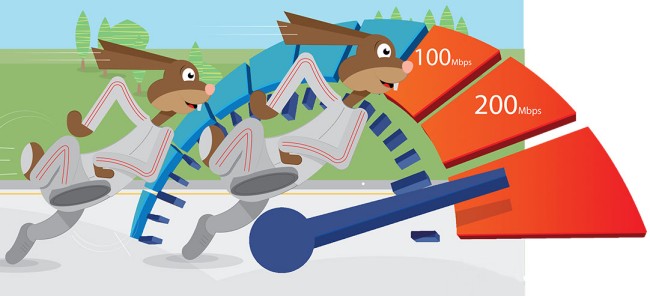What is the difference between Mbps and MB/s? What does it mean to use a connection of up to 7, 20, 30, 50, or 100 Mbps?
When it comes to the speed of the network connection, it often happens that you hear “big bangs” when you have to use units such as Gbps, Mbps, kbps, MB / s, and KB / s.
Not a few believe that notations are directly interchangeable and error, if not reflected, is often just around the corner.
What does Mbps mean, what does it correspond to, and, therefore, what is the equivalent of transferring data up to 7, 20, 100 Mbps, or 1 Gbps?
The bitrate expresses the transmission speed.
In telecommunications and information technology, the transmission speed is expressed in bps or bit/s and expresses how much information can be transferred per unit of time.
The bit, from binary digit, is the elementary unit of information processed by a computer: the values 0 and 1 represent the logical values that the bit can assume.
Therefore, the maximum transmission speed expresses the quantity of information that the link can transfer in the unit of time (we are talking about the transmission capacity of the line or channel capacity ).

The adjective “maximum” should not be underestimated: many factors influence the transmission speed: in addition to depending on the transmission medium used (optical fiber, copper cable or classic “telephone pair,” the old cable coaxial, Ethernet cable, the air in the case of wireless connections, …), is susceptible to other physical conditions (interference, saturation, …).
As we have repeatedly mentioned, the capacity of a channel in terms of bitrate decreases due to the attenuation of the signal and the noise present on the line. In the case of fiber and ADSL connections, the problem becomes important above all in the so-called last mile, i.e., in the stretch that connects the end-user with the telephone exchange (or in any case with the cabinet where the DSLAM devices that perform line functions are installed for numeric access and modulation to and from the end user’s twisted pair; see Telecom control panels and road cabinets map ).
This is why a connection is presented, commercially, using phrases such as up to 20 Mbps (ADSL) or up to 30, 50, or 100 Mbps in the case of FTTC ( Fiber-to-the-Cab, when the fiber reaches the street cabinet and not up to the user’s “modem”).
Only in optimal conditions can such speeds be reached when one is physically very close to the telephone exchange or the street cabinet. Otherwise, parameters such as attenuation and SNR will be felt by reducing the carrier that can be locked. Therefore, you get the maximum transmission speed (the decay is approximately linear concerning the distance).
The distance, the presence of any obstacles, and interference negatively affect the maximum transmission speed in a wireless connection.
It should not be underestimated, then, that the information fed into the network – before reaching the final destination – can cross many types of transport networks, which can use different transmission means. Therefore, the transmission speed could suffer further decay based on network congestion or “bottlenecks” encountered along the way.
If the incoming transmission is not adapted to the maximum transportable by the line with a lower transmission speed, information loss may occur in telecommunications. To solve this problem, the TCP protocol uses a mechanism based on waiting for the receipt of a packet (ACK), which certifies that the data has been delivered to the recipient. Furthermore, the TCP protocol can recompose the data packets that had made different journeys before reaching their destination in the day’s order.
What does Mbps mean?
The Mbps is simply a multiple of bps and is commonly used to express how much data Megabit is transferable in a second. A communication channel that can transfer up to 20 Mbps can, therefore, “move” up to 20 Megabits per second even if this value, as explained above, will be affected by attenuation, SNR, network congestion, and the bandwidth available in practice. Central, along the route, and by the target system.
With optical fiber, even non-FTTH, it is now possible to go up to 100-300 Mbps. Several telecommunications operators are starting to market FTTH ( Fiber-to-the-Home, the fiber is brought up to the end customer) connectivity up to 1 Gbps, which is equivalent to 1,000 Mbps.
Difference between Mbps and MB/s
A 7 Mbps (or Mbit/s, or Mb/s) connection allows you to download up to 875 KB/s on paper; one at 20 Mbps up to 2,500 KB/s (or KByte/s) or 2.5 MB / s (or MByte/s).
Where did these numbers come from?
First of all, we are talking about downstream profiles, or the maximum transmission speed is to be understood as referring to the data download. In the case of ADSL and VDSL connections (FTTC and FTTH fiber), the profiles are generally asymmetrical: in upload, the maximum transmission speed and, therefore, the available bandwidth is usually considerably lower.
With a 20 Mbps ADSL downstream, you often have 1 Mbps upstream so you can upload data to the Internet at a maximum of 125 KB/s.
An FTTC 30/3 fiber connection, for example, offers up to 30 Mbps downstream and up to 3 Mbps upstream.
The various speed tests usually estimate the available bandwidth in Mbps or Gbps (then evaluate the bitrate), but when you download a file with the browser, the download speed is expressed in bytes per second (KB/s or MB/s).
8 bits are used to encode a single alphanumeric character. The byte, which expresses a sequence of 8 bits, has historically become the basic element in computer architectures and the unit of measurement of memory capacity. The byte can therefore assume 256 possible values (2 8 ): never asked why the table of ASCII characters is made up of 256 “characters” (see the website ASCII Codes )?
To convert bits to bytes, therefore, divide by 8.
Theoretically, a 20 Mbps connection can transfer up to 2.5 MB/s (20 divided by 8) or 2,500 KB/s and a 100 Mbps connection up to 12.5 MB/s.
With FTTH fiber connections up to 1 Gbps, you can go, at least in theory, up to 125 MB/s.
A calculator like this helps you estimate how long it takes to transfer a file – download or upload – depending on the connection speed and file size.
This service helps to evaluate the difference between Gbps, Mbps, kbps, and MB/s, KB/s.
Obviously, the higher the data transmission speed, the greater the bandwidth shared between the various devices connected to your local network.
It goes without saying that if your connection barely reaches 7 Mbps, it will be nearly impossible for multiple client devices to stream 1440p video simultaneously.
Just remember that Netflix requires at least a connection capable of offering 3 Mbps downstream for content in standard SD quality (720p), 5 Mbps for Full HD (1080p), and 25 Mbps 4K UHD content.
Using some codecs, you can get better performance: for example, with Google’s WebM VP9 codec, you can contain the necessary bandwidth for a 4K 2160p video at “just” 17.3 Mbps or a 1080p video at 2.6 Mbps, but a lot depends on the content provider and the hardware/software configuration of the client device.

A tech-savvy writer with a knack for finding the latest technology in the market, this is what describes John Carter. With more than 8 years of experience as a journalist, John graduated as an engineer and ventured soon into the world of online journalism. His interest includes gadget reviews, decoding OS errors, hunting information on the latest technology, and so on.













